Xibaipo Scenic Spot in Shijiazhuang City, abbreviated as Xibaipo Scenic Spot, is a tourist attraction located in Pingshan County, Shijiazhuang City, Hebei Province, covering a total area of 390,000 square meters.
石家庄市西柏坡景区,简称西柏坡景区,是位于河北省石家庄市平山县境内的旅游景区,景区总面积39万平方米。
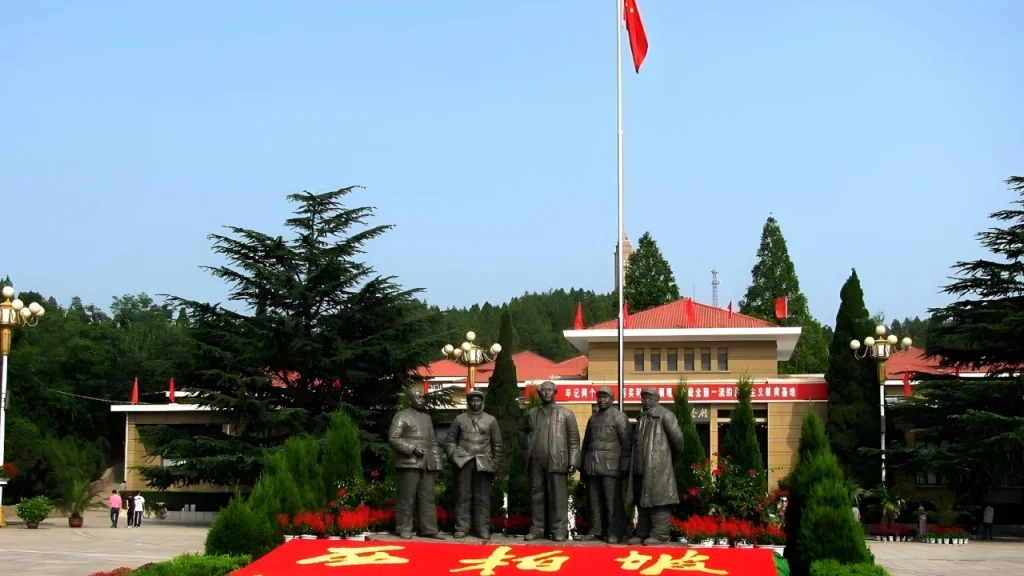
Xibaipo served as the headquarters for the Central Work Committee, the CPC Central Committee, and the PLA Headquarters during the Chinese Civil War. In May 1947 (the 36th year of the Republic of China), Liu Shaoqi and Zhu De led the Central Work Committee to settle in Xibaipo. In May 1948 (the 37th year of the Republic of China), Mao Zedong, Zhou Enlai, and Ren Bishi led the Central Leading Group and PLA Headquarters to establish their base in Xibaipo. Here, the Party Central Committee convened the CPC National Land Conference, directed the Three Major Campaigns (Liaoshen, Huaihai, and Pingjin), and held the Second Plenary Session of the 7th CPC Central Committee. The scenic area comprises two main sections: the Xibaipo Revolutionary Holy Land Tourist Area and the Xibaipo Red Classic Scenic Area. Key attractions include the Former Sites of the CPC Central Committee in Xibaipo, the Xibaipo Memorial Hall, the Xibaipo Stone Carving Park, and the National Security Education Museum, forming a comprehensive multi-level patriotic education system.
西柏坡为解放战争时期中央工委、中共中央和解放军总部的所在地。民国三十六年(1947年)5月,刘少奇、朱德率中央工委进驻西柏坡;民国三十七年(1948年)5月,毛泽东、周恩来、任弼时率中央前委和解放军总部进驻西柏坡。在这里,党中央召开了中国共产党全国土地会议;指挥了辽沈、淮海、平津三大战役;召开了中国共产党七届二中全会。景区共分为西柏坡革命圣地旅游区和西柏坡红色胜典景区两部分,可供参观的景点有西柏坡中共中央旧址、西柏坡纪念馆、西柏坡石刻园、国家安全教育馆等,已形成一个完整的、多层次的爱国主义教育体系。
On August 29, 2011, Xibaipo Scenic Area in Shijiazhuang City, Hebei Province, was officially rated as a National AAAAA-Level Tourist Attraction by the National Tourism Scenic Area Quality Rating Committee.
2011年8月29日,河北省石家庄市西柏坡景区被全国旅游景区质量等级评定委员会批准为国家AAAAA级旅游景区。
Origin of the Place Name
地名来源
Xibaipo was first established during the Tang Dynasty, originally named “Baibu” (柏卜), derived from the lush cypress trees on the hillside behind the village. In the Later Zhou Dynasty of the Five Dynasties period (10th century CE), the Hutuo River flooded, destroying the original Baibu Village. During the early Song Dynasty (early 10th century), some villagers relocated to the foot of the northern hillside to establish a new settlement. As it lay west of Dongbaibu (East Baibu), separated by reed marshes, it was named “Xibaibu” (West Baibu). In the Republic of China era (1912-1949), village teacher Qi Yujun proposed changing the character “卜” (Bu) to “坡” (Po), resulting in the current name “Xibaipo” (West Slope).
西柏坡始建于唐代,原名“柏卜”,因村后坡岭上翠柏苍郁而得名。五代后周时,滹沱河水为患,冲毁原柏卜村。宋初,部分居民迁居北坡岭下开辟立村,因与东柏卜隔苇地相对居西,取名西柏卜。民国时,由该村教师齐玉军将“卜”改为“坡”,遂演名西柏坡。
Historical Evolution
历史沿革
In May 1947 (the 36th year of the Republic of China), the Central Work Committee led by Liu Shaoqi and Zhu De established its base in Xibaipo. Here, they convened the Chinese Land Conference and enacted the Chinese Land Law Outline.
民国三十六年(1947年)5月,以刘少奇、朱德为首的中央工作委员会先期进驻西柏坡,在西柏坡召开了中国土地会议,并颁布并实施了《中国土地法大纲》。
Then in May 1948 (the 37th year of the Republic of China), Mao Zedong, Zhou Enlai, and Ren Bishi arrived with the CPC Central Committee and PLA Headquarters. From Xibaipo, they directed the strategically pivotal Liaoshen, Huaihai, and Pingjin Campaigns. As the final rural command post for liberating China, Xibaipo became the revolutionary leadership hub.
民国三十七年(1948年)5月,毛泽东、周恩来、任弼时率领中共中央和解放军总部移驻西柏坡,在此组织指挥了较为出名的辽沈、淮海、平津三大战役,西柏坡作为解放全中国的最后一个农村指挥所成为当时中国革命的领导中心。
In March 1949 (the 38th year of the Republic of China), the historic Second Plenary Session of the 7th CPC Central Committee was held in Xibaipo, adopting resolutions on party governance and military flags. On March 23, Chairman Mao and the Party Central Committee departed Xibaipo for Beijing, etching Xibaipo’s legacy into China’s revolutionary history.
民国三十八年(1949年)3月,西柏坡召开了具有伟大历史意义的中国共产党第七届中央委员会第二次全体会议,全会通过了《中国共产党第七届中央委员会第二次全体会议决议》和《关于军旗的决议》。 [2]同年3月23日,毛泽东主席和党中央离开西柏坡迁往北京,西柏坡以其特殊的贡献载入了中国革命的史册。
In 1958, Xibaipo and 19 other villages were relocated due to the construction of the Gangnan Reservoir.
1958年,由于修建岗南水库,西柏坡和东柏坡等20个村庄被搬迁。
To commemorate the 30th anniversary of the CPC Central Committee’s relocation to Xibaipo, the Former Sites of the CPC Central Committee in Xibaipo and Xibaipo Memorial Hall officially opened to the public in 1978.
1978年,为纪念中共中央和解放军总部移驻西柏坡30周年,西柏坡中共中央旧址和西柏坡纪念馆正式对外开放。
In April 2010, under the guidance of tourism authorities at all levels, Xibaipo Scenic Area initiated its bid for National AAAAA-Level Tourist Attraction status.
2010年4月,在各级旅游部门的指导下,西柏坡景区开始了国家5A级旅游景区的创建工作。
Geographical Environment
地理环境
- Location
- 位置境域
- Xibaipo Scenic Area is situated along Yingbin Road in Pingshan County, Shijiazhuang City, Hebei Province. Nestled in the eastern foothills of the Taihang Mountains and backed by Beijing and Tianjin, it lies 90 kilometers from downtown Shijiazhuang. The scenic area spans 390,000 square meters.
- 西柏坡景区位于河北省石家庄市平山县迎宾路,地处太行山东麓,背靠京、津,距省会石家庄市90千米,景区总面积39万平方米。
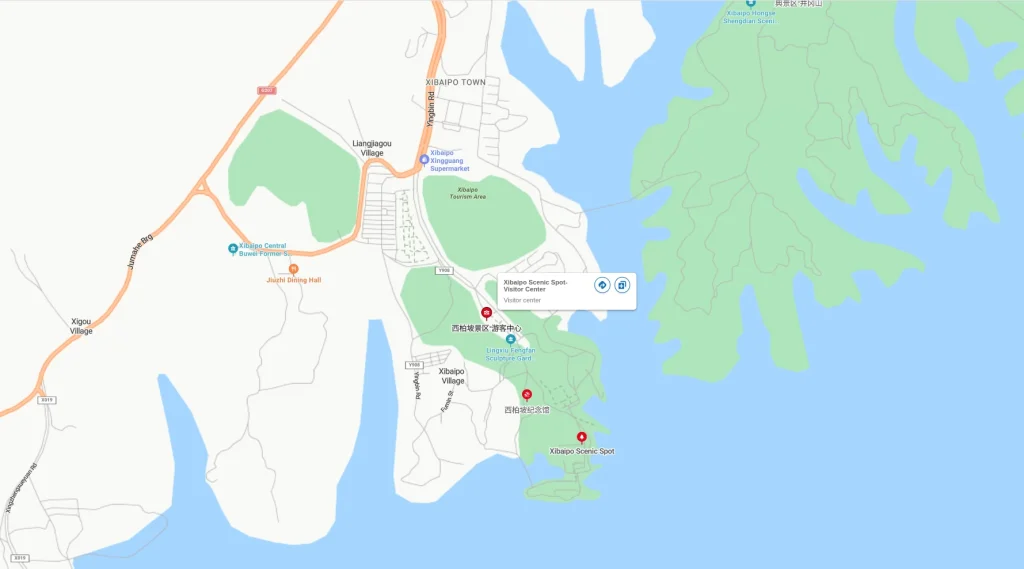
- Climate Features
- 气候特点
- Located in the warm temperate zone, Xibaipo experiences a semi-arid continental monsoon climate characterized by four distinct seasons: cold and dry winters, hot and rainy summers. The annual average temperature is 12.5°C.
- 西柏坡景区地处暖温带,属半干旱大陆性季风气候,气候特点为四季分明,冬季寒冷干燥、夏季炎热多雨, 年平均气温只有12.5摄氏度。
Scenic Area Layout
景区布局
Xibaipo Scenic Area is divided into two main sections: the Xibaipo Revolutionary Sacred Site Tourist Area and the Xibaipo Red Grand Ceremony Scenic Area.
西柏坡景区分为西柏坡革命圣地旅游区和西柏坡红色胜典景区两部分。
The Revolutionary Sacred Site Tourist Area encompasses key attractions including the Former Sites of the CPC Central Committee, Mao Zedong’s Living Quarters Exhibition Hall, Liu Shaoqi’s Former Residence, Xibaipo Memorial Hall, and Gangnan Reservoir. This area serves as the primary venue for studying revolutionary history and culture.
其中,革命圣地旅游区包括中共中央遗址、毛泽东生活馆、刘少奇同志旧居、西柏坡纪念馆、岗南水库等景点,是参观学习革命历史文化的主要场所;
The Red Grand Ceremony Scenic Area features attractions such as the Xibaipo Red Grand Ceremony Square, National Defense Education Pavilion, Pingshan Revolutionary History Exhibition Hall, and Stone Carving Park. This section focuses on showcasing revolutionary achievements and the enduring spirit of the era.
红色胜典景区包括西柏坡红色胜典广场、西柏坡国防教育馆、西柏坡平山革命历史陈列馆、石刻园等景点,是展示革命成果和精神的主要场所。
Key Attractions
重要景点
- Xibaipo Memorial Hall
- 西柏坡纪念馆
- Located within the scenic area, this hall marks the wartime base of the Central Work Committee, CPC Central Committee, and PLA Headquarters during the Chinese Civil War. Opened on May 26, 1978, it spans 13,400㎡ with 3,344㎡ of exhibition space. Housing over 2,000 revolutionary artifacts (including 15 first-grade pieces), its restored historical sites feature the former residences of Mao Zedong, Zhu De, Liu Shaoqi, Zhou Enlai, Ren Bishi, and Dong Biwu, alongside venues for the 7th CPC Central Committee’s 2nd Plenary Session and key military conferences. Recognized as a “National Outstanding Social Education Base” and “National Patriotic Education Center for Primary/Secondary Schools,” it exemplifies China’s revolutionary heritage.
- 西柏坡纪念馆位于西柏坡景区内,是解放战争时期中央工委、中共中央和解放军总部的所在地,于1978年5月26日对外开放,占地面积13400平方米,建筑面积3344平方米,共收藏了革命文物2000余件,其中一级品8类15件,命遗址复原陈列包括毛泽东、朱德、刘少奇、周恩来、任弼时、董必武的旧居,以及中国共产党七届二中全会会址、中共中央九月会议会址、中国人民解放军总部、中共中央接见国民党和平代表旧址等,已先后被评为“全国优秀社会教育基地”、“百个全国中小学爱国主义教育基地”、“全国精神文明建设工作先进单位”等。
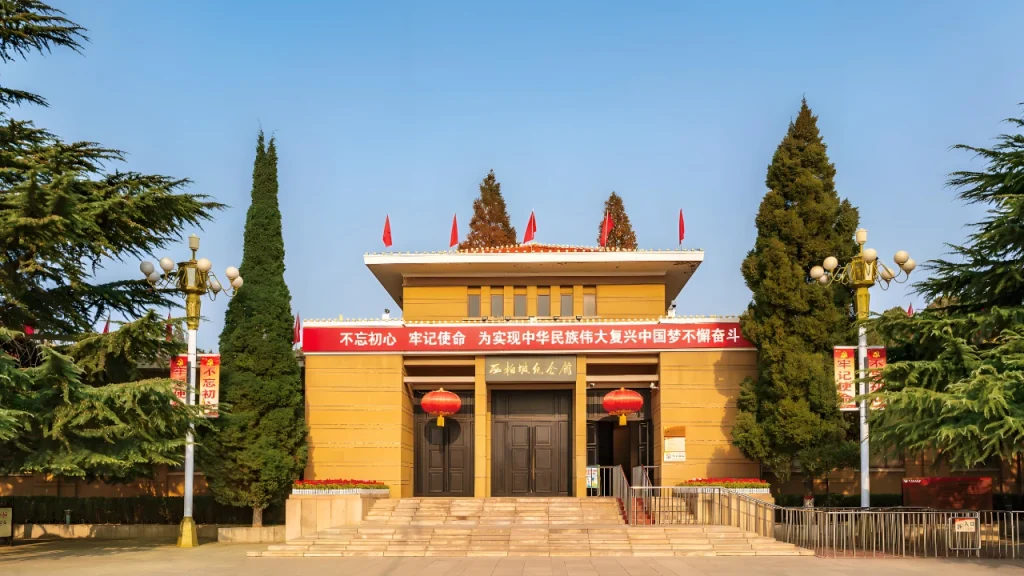
- Xibaipo Stone Carving Park
- 西柏坡石刻园
- Perched on Baipo Ridge surrounded by water on three sides, this 11,000㎡ park opened in 1997. Blending classical architecture with southern Chinese garden design, it features pavilions, terraces, and towers showcasing over 320 stone carvings by revolutionary leaders, celebrities, and calligraphers.
- 西柏坡石刻园坐落在三面环水的柏坡岭上,占地面积11000平方米,于1997年对外开放,在建筑设计上汲取了古典建筑和南方园林的特点,亭台楼榭错落有致,共镌刻老一辈革命家、社会各界名人、全国著名书法家作品共320余幅。
- Xibaipo Memorial Monument
- 西柏坡纪念碑
- Erected in 1993 (Mao Zedong’s 100th birthday anniversary) atop the hill behind the memorial hall, this 20.5-meter monument was funded by Hebei’s national defense commission. Renovated multiple times, it bears Deng Xiaoping’s calligraphy “Xibaipo” and Jiang Zemin’s 1991 inscription: “Remember the ‘Two Musts,’ Build Socialism with Chinese Characteristics.”
- 西柏坡纪念碑位于西柏坡景区停车场南侧、纪念馆后山顶上,修建于1993年毛泽东同志诞辰100周年,由河北省国防科工委捐资兴建,后几经改建,扩成现高大的碑体,总高度20.5米,碑名“西柏坡”为邓小平亲手提写,碑文“牢记两个务必,建设有中国特色的社会主义”为1991年江泽民题词。
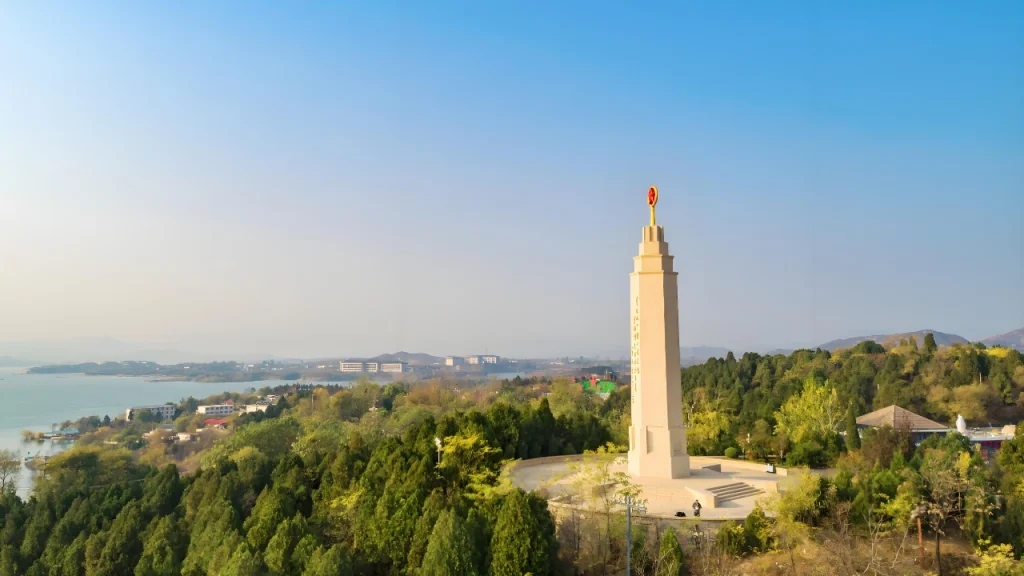
- National Security Education Pavilion
- 国家安全教育馆
- Situated at the scenic area entrance, this modern three-story building was jointly established by the Ministry of State Security, Hebei Provincial Security Department, and Xibaipo Memorial Hall. Featuring the Nameless Monument exhibition, it integrates multimedia displays, concave mirror imaging, and phantom imaging across 770㎡ of exhibition space, including 114 photos, 85 artifacts, 22 documentary excerpts, 7 dynamic models, 3 dioramas, and 1 art relief.
- 国家安全教育馆位于西柏坡纪念馆景区入口处,由国家安全部、河北省安全厅、西柏坡纪念馆共同建设,是一座现代化三层建筑,馆内有《无名丰碑》主题展览、演出厅、电影放映厅、投影厅、贵宾休息厅、报告厅等多功能场所,展览面积770平方米,有图片114副、实物85件、文摘22段、动态模型7个、场景复原3处、艺术浮雕1组。该展览运用博物馆学的最新理念,通过虚实对比,动静结合等综合设计手法,采用多媒体、凹面镜成像、幻影成像等陈列形式,融合教育、思想、科学、艺术于一体。
- Bronze Statues of the Five Secretaries
- 五大书记铜铸像
- Central to the memorial hall square, these 2.5-meter bronze statues depict Mao Zedong, Zhu De, Liu Shaoqi, Zhou Enlai, and Ren Bishi, capturing the first-generation CPC leadership’s triumphant spirit and future aspirations during the Xibaipo era.
- 五大书记铜铸像位于西柏坡纪念馆广场中央,均高2.5米,由青铜铸像,再现了西柏坡时期中国共产党第一代领导集体充满胜利的喜悦和对未来无限憧憬的情景。
- Xibaipo Youth Civilization Park
- 西柏坡青少年文明园
- Opened in May 2001 opposite the CPC Central Committee’s former sites, this 4,600㎡ park features cobblestone paths, floral sculptures, and inspirational quotes from great leaders, blending revolutionary traditions with contemporary civic values.
- 西柏坡青少年文明园位于陈列展览馆西侧,与西柏坡中共中央旧址相望,于2001年5月建成开放,占地面积4600平方米,园内卵石铺路,花草、雕塑相间,还有伟人寄语青少年的名言警句,使革命传统和时代文明浑然一体。
- Former Sites of the CPC Central Committee in Xibaipo
- 西柏坡中共中央旧址
- Located in Xibaipo Village, this complex includes brick-wood flat-roofed houses (154 rooms, 232m air-raid shelters) once inhabited by Mao Zedong, Zhu De, Liu Shaoqi, Zhou Enlai, and Ren Bishi, alongside venues for the 7th CPC Central Committee’s 2nd Plenary Session and military operations. Designated a National Key Cultural Heritage Protection Unit on March 11, 1982, it remains pivotal to understanding China’s revolutionary history.
- 西柏坡中共中央旧址坐落在西柏坡镇西柏坡村,主要包括毛泽东、朱德、刘少奇、周恩来、任弼时同志旧居、中国共产党七届二中全会会址、军委作战室旧址、九月会议会址等,建筑为砖木结构平顶房,共有房屋154间、防空洞232米。1982年3月11日,西柏坡中共中央旧址被国务院公布为全国重点文物保护单位。
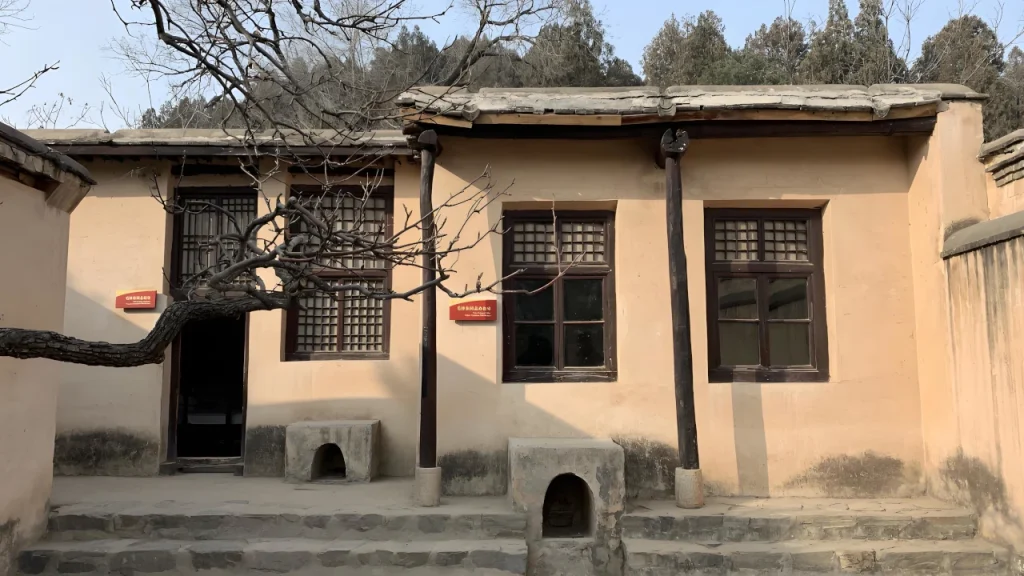
Related Culture
相关文化
Revolutionary Heritage
红色革命文化
Xibaipo, primarily known for red tourism, was praised by former Vice Premier Qian Qichen as “a sacred revolutionary site and tourism paradise.” On May 26, 1948, the CPC Central Committee, Central Military Commission, and PLA Headquarters relocated from northern Shaanxi to Xibaipo, where Mao Zedong, Zhu De, Liu Shaoqi, Zhou Enlai, and Ren Bishi reunited as the “Five Secretaries,” establishing Xibaipo as China’s revolutionary leadership center. The Xibaipo Spirit, one of the core revolutionary spirits, was articulated by Mao Zedong during the 7th CPC Central Committee’s 2nd Plenary Session. It embodies the revolutionary ethos cultivated by the CPC Central Committee under Mao’s leadership during their Xibaipo period, encapsulating Xi Jinping’s emphasis on “modesty, diligence, pragmatism, and people-first dedication.”
西柏坡以红色旅游为主,曾被原国务院副总理钱其琛赞誉为“革命圣地,旅游佳境”。1948年5月26日,中共中央、中共军委和中国人民解放军总部从陕北移驻西柏坡,在此毛泽东、朱德、刘少奇、周恩来、任弼时5位书记会合,从此西柏坡成为中国革命的领导中心。而西柏坡精神也是红色革命精神之一,由毛泽东在西柏坡召开的中国共产党七届二中全会上提出,是指以毛泽东为首的党中央在驻西柏坡期间,所体现和创立的一系列革命精神,也是习近平总书记所强调的“谦虚谨慎、艰苦奋斗、实事求是、一心为民”。
Major Historical Events
相关历史事件
Three Great Campaigns
三大战役
From September 12, 1948 to January 31, 1949, the CPC directed the earth-shaking Liaoshen, Huaihai, and Pingjin Campaigns from Xibaipo. These campaigns liberated the entire Northeast region and the cities of Pingjin (now Tianjin) and Beijing, effectively freeing the Huai-Hai River area and North China from Kuomintang control.
1948年9月12日至翌年1月31日,中国共产党在此指挥了震惊中外的辽沈、淮海、平津“三大战役”,解放了东北全境和平、津两市,基本解放了长江以北的华东中原地区和华北。
Three Pivotal Conferences
三大会议
- September Political Bureau Enlarged Meeting (September 8-13, 1948): This meeting deployed strategic tasks to overthrow the Kuomintang’s reactionary rule at its roots, making ideological, organizational, and material preparations for the final strategic offensive.
- 1948年9月8日至13日,中国共产党中央在西柏坡召开了政治局扩大会议,即“九月会议”。会议根据战略反攻新形势布置了从根本上打倒国民党反动统治的战略任务,为迎接战略大决战作了思想上、组织上和物质上的准备。
- January 1949 Political Bureau Meeting (January 6-8, 1949): Adopted the resolution Current Situation and the Party’s Tasks for 1949, outlining plans for national liberation.
- 1949年1月6日至8日,中共中央在西柏坡召开了政治局会议,通过了《目前形势和党在一九四九年的任务》的决议。
- 2nd Plenary Session of the 7th CPC Central Committee (March 5-13, 1949): Held in Xibaipo, this historic meeting provided comprehensive preparations for China’s revolutionary transition, laying the political, ideological, and theoretical groundwork for national liberation and the establishment of New China.
- 同年3月5日至13日,中国共产党第七届中央委员会第二次会议在西柏坡胜利召开,这次会议对促进和迎接全国胜利解放,以及保证中国革命实现伟大战略转变,从政治上、思想上和理论上作了必要而充分的准备。
Related Figures
相关人物
Zhou Enlai (1898-1976)
周恩来(1898~1976年)
Born in Shaoxing, Zhejiang Province (raised in Huai’an, Jiangsu Province), Zhou Enlai (courtesy name Wuhao) served as Vice Chairman of the Central Military Commission and acting Chief of the General Staff during the Xibaipo period. As Mao Zedong’s principal military assistant during the Liaoshen, Huaihai, and Pingjin Campaigns, he later participated in the September Political Bureau Enlarged Meeting and the 2nd Plenary Session of the 7th CPC Central Committee, making significant contributions to the founding of New China.
曾用名伍豪,浙江绍兴人,生于江苏淮安,在西柏坡时期任中央军委副主席兼代总参谋长,在辽沈、淮海、平津三大战役中是毛泽东在军事方面的主要助手,后还参加了九月会议和党的七届二中全会,为新中国的建立做出了巨大贡献。
Chen Yun (1905-1995)
陈云(1905~1995年)
Originally named Liao Chenyun, he served as Director of the Political Department and Secretary of the Northern Bureau of the CPC Central Committee during the Xibaipo era. Chen Yun advanced the Central Committee’s organizational development while prioritizing political education, helping numerous individuals establish correct worldviews and values. His work laid the ideological foundation for the Xibaipo Spirit.
原名廖陈云,在西柏坡时曾担任政治部主任和中共北方局书记,推动了中共中央在西柏坡的建设和发展,同时非常注重政治思想工作,通过开展思想政治工作,帮助了多人树立正确世界观、人生观和价值观,为西柏坡精神的形成奠定了基础。
Luo Ruiqing (1906-1978)
罗瑞卿(1906~1978年)
A native of Nanchong, Sichuan Province, General Luo Ruiqing (General of the Army) served as Chief of Staff of the First Red Army during the Xibaipo period. Advocating for integrating theory with practice, he conducted grassroots investigations to understand rural hardships, promoting agricultural technological improvements that significantly advanced rural political and economic development in Communist-controlled areas.
四川省南充市舞凤乡清泉坝人,为中国人民解放军大将,在西柏坡期间曾担任红一方面军参谋长,非常重视西柏坡的作用,注重理论和实践相结合,对此深入农村了解群众疾苦,提倡对农民耕种技术的改进和发展,为中共农村政治和经济的发展做出了重要贡献。
Value and Significance
价值意义
As the former seat of the CPC Central Committee, Xibaipo served as the command center where Mao Zedong and the Party leadership directed the Liaoshen, Huaihai, and Pingjin Campaigns, convened the historic 7th CPC Central Committee’s 2nd Plenary Session and the National Land Conference, and orchestrated the liberation of China. This earned it the accolades “Where New China Was Born” and “The Village That Decided China’s Destiny.”
西柏坡景区曾是中国中共中央所在地,在此党中央和毛主席指挥了辽沈、淮海、平津三大战役,召开了具有伟大历史意义的七届二中全会和全国土地会议,并解放了全中国,故有“新中国从这里走来”、“中国命运定于此村”的美誉。
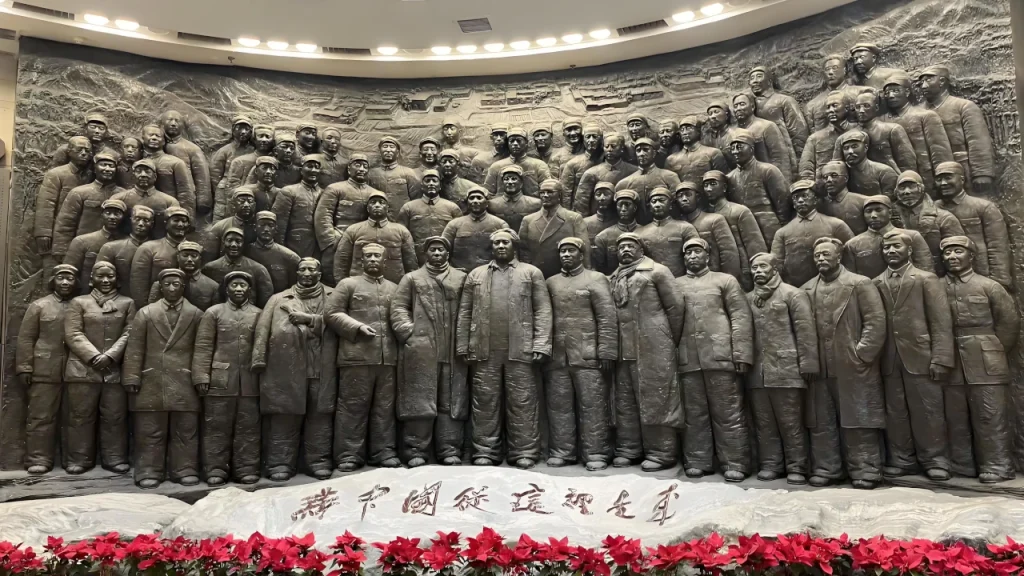
Tourism Information
旅游信息
Opening Hours: Daily 9:00-17:00 (last admission at 16:30)
开放时间:每天9:00~17:00(16:30停止进馆)
Best Visit Period: March-October
最佳游览时间:3~10月
Recommended Duration: 4-6 hours
推荐游览时长:4~6个小时
Admission: Free
门票价格:免费
Transportation
交通方式
- Self-Drive:
- 自驾:
From Beijing, take the Beijing-Shenzhen Expressway south to the Shijiazhuang-Taiyuan Expressway, exit at Shiqing, then follow Shiyan Road through Pingshan County to Changyu Ling. Turn right onto the Xibaipo Tourist Highway via Gangnan and Sujiazhuang on National Highway 207. The Xibaipo Expressway now provides direct access from Shijiazhuang, with a 40-minute drive.
从北京自驾车沿京深高速南行到石太高速出口转石太高速公路,在石青出口下,走石阎路经过平山县城到常峪岭,右拐沿西柏坡旅游公路经岗南、苏家庄走207国道直至西柏坡。此外,已有西柏坡高速公路直通西柏坡,从石家庄走高速到西柏坡大约40分钟。 - Public Transport:
- 公共交通:
Direct buses to Xibaipo depart daily at 6:50, 9:40, and 14:00 from Shijiazhuang North Passenger Station. Alternatively, take the Pingshan Express Bus to Pingshan County Bus Station, then transfer to Xibaipo.
在石家庄市客运北站有直达西柏坡景区的班车,也可以从石家庄坐平石快客到平山县汽车站,然后从平山县汽车站转车到西柏坡。石家庄客运北站到西柏坡的车次为每天三趟,时间为每天6:50、9:40、14:00。

Leave a Reply